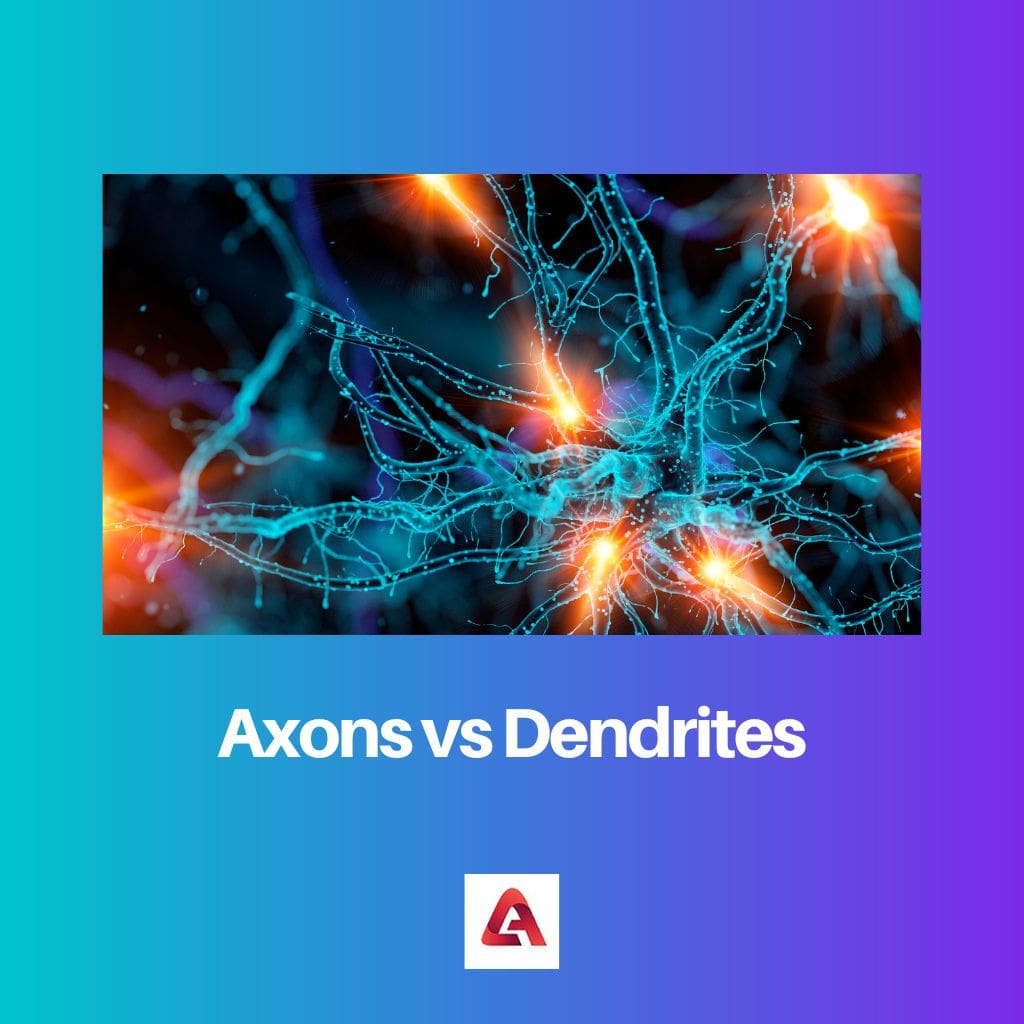Our brain has a network of neurons to communicate with other cells and carry out various tasks. Axons and dendrites are both parts of a neuron.
Key Takeaways
- Axons are the long, slender extensions of nerve cells (neurons) responsible for transmitting electrical impulses away from the cell body; dendrites are the shorter, branched extensions that receive incoming signals from other neurons.
- Axons are covered in a myelin sheath that aids in signal transmission and speeds up the conduction of electrical impulses; dendrites lack this protective covering.
- The primary function of axons is to send information, while dendrites receive and process information, allowing neurons to communicate within the nervous system.
Axons vs. Dendrites
Axons are a part of a neuron that transmits signals to other neurons or muscles. They are elongated, cable-like structures that can be several feet long in some cases. A dendron is a branched projection of a nerve cell that receives signals from other neurons and conducts them towards the cell body.

Small branch-like projections at its terminal establish a connection with other dendrites and pass the electrical signal to communicate with other neurons.
Comparison Table
| Parameters of Comparison | Axons | Dendrites |
|---|---|---|
| Shape | Elongated fiber like projection. | A small branch like projection. |
| Length | It is the longest part of a neuron. | A dendrite is comparatively shorter. |
| Structure | It contains neurofibrils but lacks Nissl’s granules and forms a synaptic knot at the end. | It contains both neuro- fibrils and Nissl’s granules. But does not form a synaptic knot at the end. |
| Number (in a single neuron) | A neuron has just one axon ( sometimes from a dendrite but originating from the soma or cell body). | A neuron has many dendrites originating from the cell body. |
| Function | It transmits the electrical signal from the soma or cell body to the dendrite of another neuron. | Dendrite receives the electric signal from the axon through the synaptic knot and brings it to the cell body of the neuron. |
What is Axon?
An axon passes the information from the cell body (Soma) to the dendrite of another neuron in the form of an electrical impulse through the synaptic gap. These axons can be a few millimeters to more than one meter long.
An axon is the long projection of a neuron with branch-like structures at the end. The axon hillock connects it with the neuron’s (Soma) cell body. It consists of a microtubule and some microfilaments.
Scientists believe these structures help transport nutrients and electrical impulses from the cell body to the axon. It is surrounded by a Myelin sheath (a kind of fatty material) in the form of Schwann cells.
At its end, the neuron splits into branch-like structures called telodendrons, whose end part is known as an axon terminal.
A neuron has one axon originating from the cell body, but sometimes axons arise directly from the dendrite.

What is Dendrite?
A dendrite is a small branch-like projection of a neuron. Dendrites have small spine-like structures on their surface on which the axon of another neuron gets attached through the synaptic gap.
The axon passes the information towards its terminal, where the dendrite receives the information in this synaptic gap through small receptors present on the surface of its spine.
Dendrites contain ribosomes, smooth endoplasmic reticulum, Golgi apparatus, and cytoskeletal structures.
A large number of dendrites with a branch-like structure increases the surface area of a neuron to connect with other neurons.

Main Differences Between Axon and Dendrite
- An axon may be originated directly from an axon, but a dendrite does not arise from an axon.
- A dendrite has several receptors on its surface to receive the electrical impulse in the form of some chemical which again turns into an electrical signal or impulse before sending it to the cell body (soma), but axons lack such receptors.

- https://ieeexplore.ieee.org/abstract/document/6268815/?casa_token=s544zcKUO2YAAAAA:rN41VzA3auSOWE4MX7T3671hagvt2NWBl7fayF0Imz7PJq7WUuBCwDrEy0HE8X0MDZcqaJyMm7Y
- https://www.sciencedirect.com/science/article/pii/S095943889900046X

The article effectively elaborates on the structure and functions of both axons and dendrites.
Indeed, it’s beneficial for those delving into the subject of neuroscience.
The comprehensive explanations work well to convey a thorough understanding of axons and dendrites.
This article is very informative about neurons. It has a lot of detail about axons and dendrites.
Yes, I agree. The article provides essential information to help people understand the nervous system better.
The article provides a comprehensive understanding of axons and dendrites.
The post is highly detailed, making it a beneficial resource for those seeking information regarding axons and dendrites.
Absolutely, and it can serve as a reference for those studying neuroscience.
The scientific explanations make this article an excellent resource for anyone interested in the topic.
Great explanation of axons and dendrites. Detailed but easy to follow.
Yes, the content manages to be detailed without being too complex. It’s a good balance.
Yeah, striking a balance between informative and understandable language is a great feat in scientific writing.
A well-structured and informative article providing a detailed understanding of axons and dendrites.
I agree, the structure and detail make it a valuable resource for understanding these components of neurons.
The informative nature of the article makes it a beneficial read for those interested in neuroscience.
A compelling overview of axons and dendrites’ primary functions.
The comprehensive insight into the functioning of axons and dendrites can benefit those seeking clear explanations.
Absolutely, the article helps in understanding how neurons communicate more effectively.
The scientific references in this post back up the information provided. It seems reliable.
The references enhance credibility, making the article seem more factual and trustworthy.
Yes, especially the IEEE explore abstract document. It shows that the content is well-researched.
The differences between axons and dendrites are clearly explained. Easy to understand.
The comparison table helps highlight the disparities, making it easier to grasp the unique functions of axons and dendrites.
Absolutely. It’s beneficial for those who are learning about neurons.
The detailed comparison of axons and dendrites is insightful.
Yes, the post offers a clear distinction between these two components of neurons.